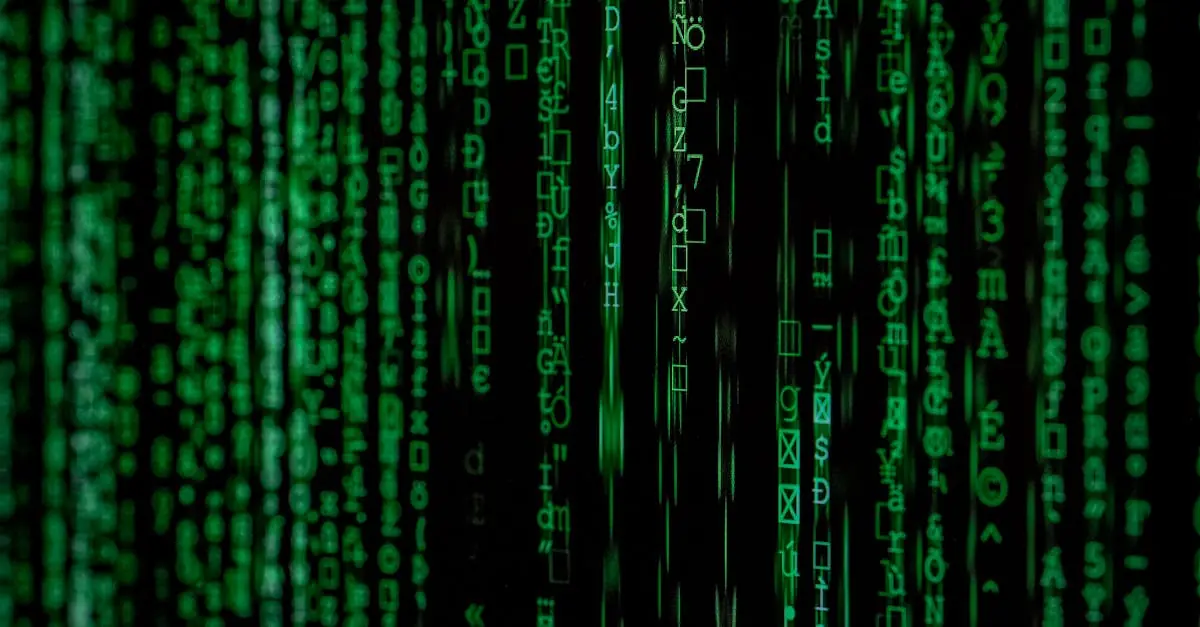In a world where security breaches are as common as cat videos, blockchain encrypted QR codes are the superheroes we didn’t know we needed. Imagine a QR code that not only takes you to a website but also ensures that your data is locked tighter than a vault in a heist movie. With the power of blockchain technology, these codes are revolutionizing how we share information—making it safer, smarter, and a little more fun.
Table of Contents
ToggleOverview of Blockchain Encrypted QR Code
Blockchain encrypted QR codes enhance data security significantly. These codes leverage blockchain technology to create a secure environment for transactions and information sharing. Users scan the QR code to access websites while their data benefits from encryption. This process ensures unauthorized access remains nearly impossible.
Security features of blockchain encrypted QR codes include immutability and transparency. Immutability protects data from being altered once recorded on the blockchain. Transparency allows users to verify the authenticity of the information associated with the QR code easily.
Managing sensitive information becomes simpler with these encrypted codes. Businesses utilize them for secure payments, identity verification, and access control. A variety of industries, including finance and healthcare, have adopted this technology to safeguard customer data and enhance trust.
Integration of blockchain with QR codes provides additional advantages. It streamlines processes and reduces fraud risks effectively. Organizations can access real-time data updates, making it easier to track information across platforms.
Adopting blockchain encrypted QR codes leads to greater customer confidence. By ensuring secure transactions, businesses build relationships based on trust. Efficient data management and streamlined processes encourage wider acceptance of this technology in various fields.
How Blockchain Encryption Works
Blockchain encryption secures data through a decentralized network that enhances privacy and integrity. This process includes various components that work together to protect information.
Key Components of Blockchain
Blockchain relies on several key components, such as blocks, nodes, and consensus mechanisms. Each block contains transaction data, a timestamp, and a cryptographic hash of the previous block, linking them together sequentially. Nodes serve as participants in the blockchain network, maintaining a copy of the ledger and ensuring transparency. Consensus mechanisms, like Proof of Work or Proof of Stake, validate transactions and prevent unauthorized interference. These elements create a robust system that resists alteration, providing users with confidence in the security of their data.
QR Code Generation and Encryption Process
Generating a blockchain encrypted QR code begins with creating a unique QR code linked to specific data or transactions. Data is then encrypted using cryptographic algorithms, such as AES or RSA, ensuring unauthorized access remains impossible. After encryption, the secure data is integrated into the QR code, making it easy to scan. When users scan the code, their device decodes the encrypted information, allowing secure access to the underlying data or transaction details. This process implements strong security measures, effectively safeguarding personal and sensitive information during transmission.
Benefits of Using Blockchain Encrypted QR Codes
Blockchain encrypted QR codes offer unique advantages that enhance security and data management. Organizations increasingly adopt these codes for a variety of applications due to their robust features.
Enhanced Security Features
Security features stand out with blockchain encrypted QR codes. The encryption process protects user data during transmission. Unauthorized access becomes nearly impossible because the data remains hidden behind complex cryptographic algorithms. Immutability plays a crucial role in security, as it prevents any alteration of information once recorded. Users gain peace of mind knowing their sensitive data stays safe. Many industries, including finance and healthcare, benefit from this added layer of protection, thereby increasing overall transaction security.
Improved Data Integrity and Transparency
Data integrity and transparency improve significantly with the use of blockchain encrypted QR codes. Each code links to specific, unchangeable data, allowing users to verify authenticity easily. Users can trust that the information accessed remains consistent and tamper-proof. Transparency enhances user confidence, as stakeholders can track transactions without ambiguity. Organizations also benefit from real-time updates, enabling them to respond swiftly to any discrepancies. This blend of integrity and transparency solidifies the reliability of blockchain encrypted QR codes across various sectors.
Use Cases for Blockchain Encrypted QR Codes
Blockchain encrypted QR codes find widespread applications across various sectors, enhancing security and efficiency. Here are some prominent use cases:
Supply Chain Management
Supply chain management benefits significantly from blockchain encrypted QR codes. These codes allow for real-time tracking of products, ensuring transparency from origin to destination. Companies can scan codes to access detailed information about product history and handling. This verification process minimizes the risk of counterfeit goods entering the supply chain. Additionally, the immutable nature of blockchain reduces discrepancies in data, fostering trust among suppliers and consumers. Stakeholders gain quick access to essential information, such as production timelines and shipment statuses, promoting accountability throughout the supply chain.
Digital Identity Verification
Digital identity verification utilizes blockchain encrypted QR codes to enhance security in personal authentication processes. Individuals can scan these codes to confirm their identity securely and conveniently. These codes store encrypted personal data, making it accessible only to authorized parties. This approach reduces identity theft and fraudulent activities. Organizations streamline user verification processes, allowing for faster onboarding and reduced costs. Furthermore, users maintain control over their sensitive information, deciding when and with whom to share it. This reinforces user confidence in digital transactions, paving the way for safer interactions across online platforms.
Challenges and Limitations
Blockchain encrypted QR codes present several challenges and limitations that may hinder their widespread adoption and effectiveness.
Technical Barriers
Technical complexities pose significant obstacles for implementing blockchain encrypted QR codes. Users often face issues related to integrating existing systems with new blockchain technologies. Scalability remains a concern as the volume of transactions increases, potentially leading to slower processing times. Additionally, varying blockchain protocols complicate the standardization of QR code generation and usage. Security measures, while robust, still require ongoing updates to address emerging threats. Users benefit from clear guidelines and support during implementation to navigate these technical barriers effectively.
Adoption Issues
Adoption challenges affect the growth of blockchain encrypted QR codes in various sectors. Awareness levels among businesses and consumers remain limited, impeding understanding of the advantages these codes offer. Moreover, resistance to change often stems from perceived risks associated with new technologies. Financial investments in software, hardware, and staff training also pose barriers, especially for smaller organizations. Enhancing education about the benefits and security features of blockchain encrypted QR codes can drive greater acceptance. Establishing trusted partnerships and pilot programs may encourage organizations to explore this technology more fully.
Conclusion
Blockchain encrypted QR codes represent a significant advancement in data security and transaction integrity. By leveraging the power of blockchain technology, these codes offer a reliable method for protecting sensitive information while facilitating seamless access. As businesses increasingly recognize the importance of safeguarding customer data, the adoption of this technology is likely to grow.
The unique features of blockchain encryption provide users with enhanced transparency and immutability, fostering trust in digital interactions. While challenges remain in terms of integration and awareness, the potential benefits far outweigh the obstacles. As more organizations embrace blockchain encrypted QR codes, they pave the way for a more secure digital landscape, ultimately transforming how information is shared and verified across various industries.




